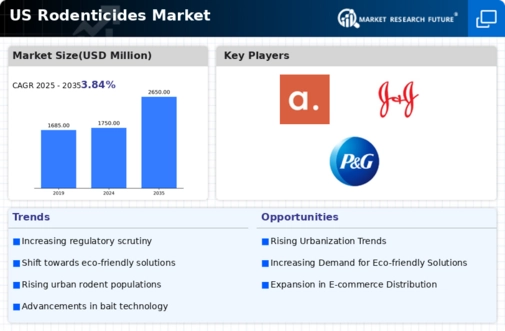Increased Awareness of Health Risks
Growing awareness of the health risks associated with rodent infestations is propelling the rodenticides market. Rodents are known carriers of various diseases, including hantavirus and leptospirosis, which can have severe health implications for humans. This awareness has led to a surge in demand for effective rodent control measures, with the market projected to grow by approximately 10% annually. The rodenticides market is responding to this demand by developing more targeted and effective products, ensuring that consumers are equipped with the necessary tools to mitigate health risks associated with rodent populations.
Advancements in Formulation Technology
Innovations in formulation technology are significantly impacting the rodenticides market. The development of new active ingredients and delivery mechanisms has enhanced the effectiveness of rodenticides, making them more appealing to consumers and pest control professionals alike. For instance, the introduction of bait formulations that are more palatable to rodents has shown to increase bait uptake by up to 30%. This advancement not only improves efficacy but also reduces the amount of product needed, aligning with environmental sustainability goals. The rodenticides market is thus witnessing a shift towards more efficient and effective solutions, driven by these technological advancements.
Rising Demand from Agricultural Sector
The agricultural sector's growing demand for rodenticides is a key driver for the rodenticides market. Farmers are increasingly recognizing the need to protect their crops from rodent damage, which can lead to significant economic losses. Reports indicate that rodent damage can account for up to 20% of crop yield losses in certain regions. This has prompted farmers to invest in rodenticides as a preventive measure, thereby boosting the market. The rodenticides market is adapting to this demand by offering specialized products tailored for agricultural use, ensuring that farmers have access to effective rodent control solutions.
Rising Urbanization and Pest Incidence
The increasing trend of urbanization in the US is contributing to a higher incidence of rodent infestations, thereby driving demand in the rodenticides market. As more people move to urban areas, the density of human populations creates ideal conditions for rodents to thrive. This urban expansion has led to a reported 15% rise in pest control service requests over the past year. Consequently, pest control companies are increasingly relying on rodenticides to manage these infestations effectively. The rodenticides market is thus experiencing growth as urban areas seek efficient solutions to combat rodent populations, which can pose health risks and damage property.
Regulatory Support for Pest Control Solutions
Regulatory frameworks in the US are increasingly supportive of pest control solutions, including rodenticides, which is beneficial for the rodenticides market. Agencies such as the Environmental Protection Agency (EPA) are working to streamline the approval process for new rodenticide products, ensuring that effective solutions are available to combat rodent infestations. This regulatory support is crucial, as it encourages innovation and investment in the rodenticides market. As a result, companies are more likely to introduce new products that meet safety and efficacy standards, ultimately enhancing market growth.














Leave a Comment